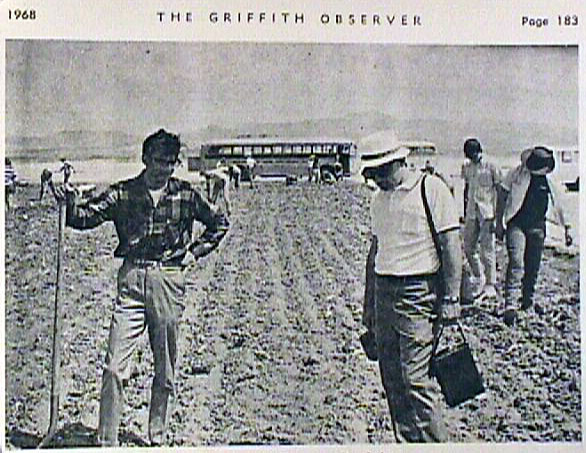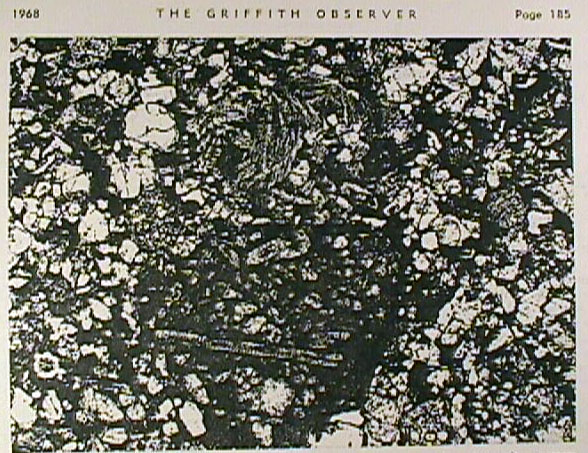
*Five Lucerne Valley aerolites. The relatively good state of preservation of these meteorites indicates that they probably fell within the last 100 years*
(The following article was written by Ron Oriti and is from the December 1968 issue of the "Griffith Observer", reprinted with the authors permission - ed.)
LUCERNE DRY LAKE REVISITED
One July 21, 1963 my colleague and long-time friend, Ronald N. Hartman, found the first stony meteorite on Lucerne Dry Lake. What made this especially noteworthy was the fact that he had gone to the dry lake in search of meteorites, and had found one. The discovery was a new find in California, and new finds are almost never made on purpose. When new meteorites are found, they are usually stumbled upon by unsuspecting campers or hikers.
About two weeks prior to this, Hartman and I had concluded in private conversation that the dry lakes should be good places for finding meteorites. The reasons for this may be summed up as follows:
1. Dry lakes are large areas relatively devoid of vegetation and rocks. Any meteorites on their surfaces appear conspicuous.
2. Their surfaces are often hardpan, so those small meteorites, which fall with low speed, will be unable to break through and be buried.
3. The rate of sedimentation and erosion is low, making it less likely that meteorites on the surface will be buried.
4. They are easily searched by jeep or by bicycle, so that many square miles can be covered with relative speed and comfort.
Hartman had chosen Lucerne Dry Lake because it was favorably located with respect to other California meteorite finds, and his choice, it turned out, was excellent. During the next few weeks, Roderick W. Leonard and I joined him, and six more meteorites were found. However, thereafter all of our attempts to find more specimens were unsuccessful, and we abandoned the search for more than a year.
On December 5, 1964, with the help of two science teachers, Howard Lieberman and Thomas Nash, of Antelope Valley High School, we led an expedition of about one hundred high-school students over the lake in search of meteorites. The students carried collecting bags, and were asked to gather up every rock and pebble they encountered. The results were disappointing; only one small meteorite was recovered, and by coincidence it was found by Howard Lieberman's son, Steve.
Many months later another small meteorite was found by Darryl Futrell after a few days' search. And then early in 1966 still another one was found by Alan Crisp.
It was puzzling to us why so few, and such small, specimens had been found. They were evidently part of a shower of stones that resulted when a meteorite of some size plunged into the atmosphere and shattered. At Holbrook, Arizona in 1912, a shower of more than 16,000 stones with a total weight of about 500 pounds rained down upon the desert. While the Lucerne Valley fall was probably considerably smaller than this, it should still have been large enough to produce a significant quantity and weight of meteorites, but all it had produced was 10 small stones with a total weight of only a little more than 100 grams.

*Five Lucerne Valley aerolites. The relatively good state of preservation of these meteorites indicates that they probably fell within the last 100 years*
It is unlikely if not impossible that a specimen of just a few hundred grams would break up into ten or more pieces. There must be more specimens somewhere out there, but the question is - where?
When a meteorite shatters in the atmosphere, the smallest pieces, because of air resistance, lose their original speed very quickly and tend to drop straight down. The larger pieces retain more of their original cosmic velocity and continue on to greater distances. The affect is to distribute meteorites over an area which has roughly the shape of an ellipse. The larger meteorites are found toward the front of the ellipse while the smaller ones are found toward the back.
With only ten small specimens it was not possible to determine the ellipse of fall. However, we did make guesses as to how big the ellipse might be and where we might expect to find the larger specimens. Our searches unfortunately failed to substantiate our expectations.
We finally concluded that there was a good chance that larger meteorites had buried themselves in the lake. Perhaps, if the lake were plowed, larger specimens would be brought to the surface. After interviewing the necessary land owners, I hired a nearby farmer to plow up an acre or so of the dry lake. Once again Antelope Valley High School was asked to cooperate. Mr. Lieberman and Mr. Nash responded with enthusiasm and another expedition of 100 high-school students was organized.

*Plowed area of Lucerne Dry Lake*
We revisited Lucerne Dry Lake on May 3, 1968 equipped with rakes and other gardening tools. The students were turned loose on the plowed area with the hope that they might discover a meteorite which had been brought to the surface. After an hour's raking in the hot sun, not a single rock or pebble was found, and the group began to get discouraged. It was evident that no large meteorite had been turned up and that the smaller meteorites, if any, would be too coated with clay to be recognized. We decided to abandon this phase of the expedition and to let the students search, as they did previously, for rocks and pebbles scattered over the lake.
Since the lake had been picked fairly clean by this time, we were not too hopeful of finding more specimens. It was, therefore, most gratifying to find at the finish that the expedition had achieved a modicum of success with the discovery of another two small meteorites, numbers 11 and 12. The lucky finders were Richard Russell, a student, and Darwin Ochs, a science teacher. Their specimens were kindly donated to the Griffith Observatory, and along with the other Lucerne Valley stones are now there on display.

*Searching for meteorites*
The students and faculty of Antelope Valley High School have shown the qualities so necessary to succeed in science, namely enthusiasm, perseverance, and patience, and they have learned that there may be many failures before success is achieved.
In retrospect, it appears obvious that we had plowed too small an area to expect significant results. Ideally the whole lake and some adjoining land should be plowed. This, however, is too expensive an enterprise for us to undertake, and there is of course no guarantee of success.

*Thin-section of Lucerne Valley aerolite showing chondrules, rounded grains which often possess intricate structure and are never found in terrestrial rocks. Irregular black patches are flecks of nickel-iron metal grains. They appear black here because they do not transmit any light, which in this case comes from beneath the section. A plate-like mineral seen edge-on appears as a rod. (Thin-section made by John DeGrosse and photograph by Lowell S. Weymouth, Geology Dept., U.C.L.A.)
The 12 specimens so far found appear to be mineralogically related. They are classified as olivine-hypersthene chondrites, a type of stony meteorite. They contain about 4% nickel-iron metal disseminated as flecks throughout the specimens. For this reason they are weakly attracted to a magnet.
Their surfaces are mainly covered by a nearly black fusion crust, which resulted from the cooling of a thin layer of molten material formed during passage trough the atmosphere. The fact that the fusion crust is nearly black indicates that the meteorites are relatively fresh, and probably fell within the last fifty years. Meteorites which have lain on the earth for much longer periods, have their fusion crust oxidized to a brownish color.
One of the specimens has tiny pits on its back surface. Such pitting is also found on the Muroc, California stone and is not unusual. The partial vacuum which exists on the back side of an oriented meteorite, during its fall through the atmosphere, allows the gases to escape from the molten surface producing a kind of frothing which gradually becomes more viscous as the aerolite cools, and eventually it hardens, preserving the small bubble pits.
In the following table we list the meteorites so far found on Lucerne Dry Lake.
(ed. [R. Verish, 2001] - NOTE: This list was revised on Feb. 13, 2001) Find# Weight Date Found Finder (Holder of Main Mass) No. (grams) (Mo. Yr.) 1 15.8 Jul 1963 Ronald N. Hartman (Dupont) 2 5.8 Aug 1963 Ronald A. Oriti (Finder) 3 7.5 Aug 1963 Ronald A. Oriti (?) 4 37.4** Oct 1963 Ronald N. Hartman (Finder) 5 3.1** Oct 1963 Ronald N. Hartman (IG&PP) 6 26.9 Nov 1963 Roderick W. Leonard (?) 7 4.8 Nov 1963 Roderick W. Leonard (?) 8 2.0 Dec 1964 Steve Lieberman (Griffith) 9 3.0 Apr 1965 Darryl Futrell (Griffith) 10 6.4 Dec 1965 Alan Crisp (Griffith) 11 3.8 May 1968 Richard Russell (Griffith) 12 1.2 May 1968 Darwin Ochs (Griffith) (hiatus) 13 4.1 May 1992 Byron Groves (Finder) 14 3.4 Sep 1998 Beth and Bob Verish (Griffith) 15 12.5 Oct 1998 Bob Verish (Griffith) 16 4.1 Nov 1998 Bob Verish (Griffith) 17 12.8 Mar 1999 Ron Hartman (Finder) Total Weight ~154.7 grams (not to be inferred that these all came from the same fall) ** = physically paired by finder. (Dupont) = last reported to be in the James DuPont Collection. (IG&PP) = consumed by UCLA lab during analysis & testing for Fe%. (Griffith) = on display at Griffith Observatory, Griffith Park, Los Angeles, CA
("Click" HERE for a description regarding the recent finds!!
(ed. [R. Verish, 2001] - NOTE: End of "Revised" text)
The question of where the rest of the Lucerne Valley fall is located is still unanswered. All of the specimens found can be included within an area about 1.5 miles long and about 0.7 miles wide. This area probably represents the back portion of the ellipse of fall. In which direction the ellipse is oriented as well as its size is a matter for speculation. The evidence supports the conclusion that these meteorites have resulted from a high altitude burst and are spread out over a wide area.
If anyone finds any suspected meteorites within ten miles of Lucerne Dry Lake, I would be most interested in examining them.
-Ronald A. Oriti
(ed. [R. Verish, 2001] - NOTE: It has since been shown that there is not just one fall, but at least 7 falls on Lucerne Dry Lake!)